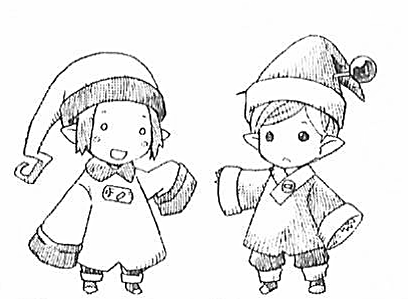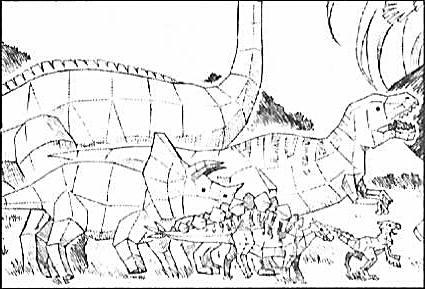Jinrui wa Suitai Shimashita:Volume 1 Epilogue
April Monthly Report
1. First Half
With the appointment of a new employee, the village administration of Camphorwood has initiated communications with fairy mankind (hereby, the fairies) and human mankind.
Initially, it was expected that establishing a dialog with fairies, who occupy a wide area and never settle, would be difficult.
Based on that employee's plan, a new collection method was implemented. As a result, four fairies were successfully contacted.
Communications were thus established with utmost tranquility and legitimacy, and there were no problems.
Although these four fairies had individual discriminators unique to them, they could not necessarily be accurately distinguished when mixed with large numbers of their kind.
To remedy this, the employee proceeded to give the four fairies names. Due to their customary lack of names, the fairies gladly accepted and treated the names with curiosity as was characteristic of their race.
Dialog was smoothly advanced, with the fairies having adopted the names "Cap", "Nakata", "Fishroll" and "Sir. Christopher McFarlane" (see Figure I).

After this, the fairies, who were in the dispersal stage, shifted to that of aggregation.
It is believed that the majority of the fairies living in the neighboring regions were also attracted, greatly increasing their population density.
Due to this, an abnormal rise in the fairies' cultural and scientific standards was observed.
When this occurred, a gigantic play-city was created overnight, which spoke to the extent of their numbers.
Our employee observed these developments with caution and restraint.
At times, the employee was also asked to participate in the fairies' games; regional interaction proceeded favorably, and there were absolutely no problems encountered.
As documented in existing research reports, the aggregation stage was relatively short (roughly five to seven days), and soon transitioned into the dispersal stage.
These figures are a result of the minimal regard the fairies customarily express towards their own creations.
In addition, the week-long time interval calculated was consistent with the figures recorded in Camphorwood's own historical records, lending the data more credence.
However, this time, the transition occurred within an unprecedented time span; the fairies reverted to the dispersal stage after roughly two days.
While the reason for this is actively being investigated, there is no clear solution in sight.
While there is no denying the possibility of any misconduct on the employee's part, it would be prudent to consider the existance of other, unknown causes as well.
Care must be taken to prevent human culture from unduly influencing fairy culture, which advances rapidly when in the aggregation stage.
In particular, the evils unique to humanity -- such as serious crimes -- are considered extremely hazardous to the fairies, who have highly advanced technology at their disposal.
Excessive interference in fairy affairs not only contravenes the guidelines set by the Mediation Council, but also makes the job of a mediator proportionally more difficult.
From such a perspective, there were honestly no problems at all in the cognizance of the concerned employee, and there was no transmission of concepts such as highly influencial cult-like religion at all, such things were completely out of the question indeed.
2. Final Half
Following the first half, a second aggregation event was confirmed to have occurred in the second half as well.
An artificial savanna environment was discovered that appeared to cut through some old high-rise ruins four kilometers down Camphorwood's seventh trade road.
Upon investigation by the concerned employee, it was found that a large number of fairies had established a pseudo-primitive way of life within the savanna.
Once again, the fairies named "Nakata" and "Fishroll" were seen in the area.
Their lifestyle appeared to imitate that of "the dawn of humanity", and is conjectured to be the product of "human mimicry", which is characteristic of the fairy race.

Also residing on the savanna was a large population of imitation dinosaurs (there is no evidence pointing to the coexistance of dinosaurs and humans at any point in history, but such things are regarded as one of the maxims of fairy-kind) made of papercraft (See figure II).
Powered only by the force of contracting rubber bands, these papercraft creations appeared simple, but their immensely complex internal structure reaffirmed assessments of how technologically advanced the fairies were.
These dinosaurs were observed by the concerned employee themselves, who was on their way to deliver a gift (of various confectionaries) as a gesture of friendship.
Furthermore, no fairies were harmed in the process of the ensuing interaction, and there were absolutely no problems whatsoever.
After this, it was found that the papercraft dinosaurs had the propensity to hide precious items such as sweets within their bodies, and this resulted in the fairies becoming aware of the concept of hunting. Since the dinosaurs were autonomous, the only way to stop them and acquire the hidden sweets was to physically dismantle the papercraft.
The violent custom of hunting was most definitely not instilled by the concerned employee, and there were absolutely no problems of any kind.
Again, nothing beyond the limits of a hunting game occurred, and there appears to be nothing particularly alarming about any of these developments.
Observation was halted once the transition to the dispersion phase occurred.
In addition, due to the large number of papercraft creatures released into the savanna, a portion of them have managed to survive the swell in hunting pressure, and still remain.
Though some specimens may have spread outside the confines of the ruins, there are absolutely no risks, and considering that they are made only of paper, it is likely that they will cease to function in the near future.
However, there still exists the possibility that the papercraft may evolve some functionality to preserve their state of activity, and in the long term, the possibility of witnessing nonsense such as evolution, various mutations, or natural selection from henceforth is not zero. As an intercessor, with the viewpoint of non-interference, who is not directly related to any of these developments, it is my earnest hope that such developments will converge without issue, and there will be no problems in the future.